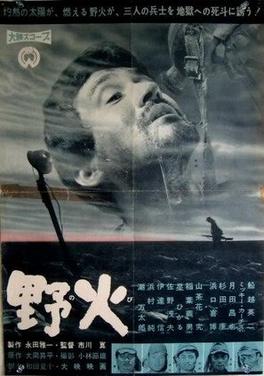If you want to watch a horror/war movie, “Fires on the Plain” may be for you. There are other horror movies set in war, but few are based on actual events. This movie is set in the Philippines in 1945 after the American invasion. The Japanese army is on the run and in terrible shape. Director Kon Ichikawa used the novel of the same name by Shohai Ooka as his source. The book and film are meant to be surrealistically anti-war. Mission accomplished.
The movie opens with the protagonist Tamura being scolded by his commander for returning from the hospital, thus giving him another mouth to feed. Tamura is suffering from TB, but not bad enough for the doctors at the hospital. The officer orders Tamura to go back and if they won’t take him, to use a grenade to commit suicide. Tamura says “Yes, sir” and starts on his odyssey as the most pitiful Odysseus in film history.
When he reaches the hospital, the doctor throws him out again and he joins similar “not-sick-enoughs” existing nearby. The only food they have is a little rice and some yams. The actors look appropriately emaciated after preparing for the movie by eating very little and not brushing their teeth or cutting their nails for weeks. The hospital is bombed in a powerful and unforgiving scene. Tamura escapes the destruction and does not go back to see about the wounded. This is the first example of the ambiguity of his war-tested humanity.
In a surprise to American audiences, most of the Japanese soldiers we meet are not gung-ho about dying for the emperor. They are not robotic followers of orders. Most of them simply want to survive. One of them dreams of being taken captive so he can eat American corned beef. At one point, Tamura reaches a village where in a wild confrontation he bayonets a dog that jumps at him. He encounters a young couple who have come back for their hidden cache of salt. When the girl screams, Tamura (seemingly out of character) kills her in cold-blood. Some more humanity slips away. The boy escapes and Tamura gets the salt.
Tamura hooks up with three survivors from his unit. They are part of a thread-bare procession evacuating from Luzon. He shares his bag of salt. They eat the salt straight! In an iconic scene, a soldier exchanges his boots for a pair found on the trail. A series of soldiers do the same with each abandoned pair worse than the last. They have to cross a road with tragic results when tanks attack. The deaths and explosions are unrealistic, but cool.
The film’s central ickiness of cannibalism rears itself when Tamura meets an insane guy who offers for Tamura to eat him when he dies. Tamura declines, but when he links back up with buddies Yasuda and Nagamatsu they are surviving on “monkey meat”. Tamura catches Nagamatsu hunting “monkeys”. When Yasuda gets Tamura’s prized hand grenade, Nagamatsu and Tamura reason it’s them or him. They lay an ambush and kill him, but then Nagamatsu proceeds to carve up the body (thankfully off camera). Tamura shoots the bloody faced, zombie-like Nagamatsu. Alone, Tamura stumbles off toward a fire on the plains which turns out to be…
This is a fascinating movie. There are striking images throughout. The black and white is crisp. The camera angles are interesting with Achikawa using up close facial shots and also long range shots of small figures in nightmarish landscapes. The acting is good. There is some very black humor. The most important reason to see this film is it explodes the myth that all Japanese soldiers were suicidal and refused to surrender. It was naturally controversial in Japan. Watching it will make you hungry and sad. Eat something salty, but not human.
GRADE = B+

Great review about a movie I have never heard of and am very curious to see. I bought a Korean horror war movie recently but haven't watched it yet. It's a combination that strikes me as particularly apt. Letters home from Iwo Jima does also depict Japanese soldiers who are less than keen to die for their Emperor. I might review it soon.
ReplyDeleteThanks. It is a bleak movie. You might want to wait a bit on it.
ReplyDelete